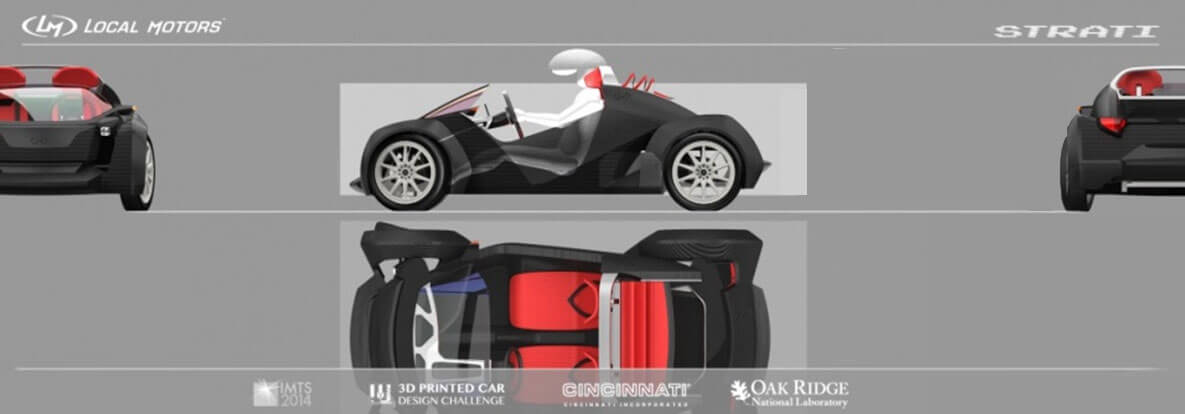The World’s First 3D Printed Car is Highway Ready

It has been traditionally believed that cars are expensive to produce, due to the fact that we have been producing them in the same way since 1915. Thousands of individual parts are painstakingly put together in assembly lines. However, the cars of the future do not have to undergo this expensive process. Automobile designers and engineers over at Local Motors have decided to tackle this problem in an innovative way- using rapid prototyping technology to print out entire cars!
Making of the Car
‘Strati’, the cute little brainchild of Local Motors, has more to it than what meets the eye. Local Motors, Oak Ridge National Laboratory and Cincinnati Incorporated joined forces to create sheer 3d printed awesomeness for the future. At the International Manufacturing Technology Show in Chicago, this electric car was printed in just under 44 hours. Currently, Jay Rogers, CEO of Local Motors has it parked at his garage in Knoxville, Tennessee.

This small two-seater is going to be produced in two factories which are going to have one hundred employees each. The original plan of Local Motors is to produce their own little Stratis, however, they could also end up supplying them for manufacturers of original equipment. This would be an excellent option for rapid prototyping of cars in the existing method, or road ready cars could be manufactured by 3d printing! This is known as Direct Digital Manufacturing or DDM, which is not only limited to this method of production. It was initially expected that the model will be highway ready by 2017, however Strati can already be charged up and driven around as it is. Part of Oak Ridge National Laboratory’s Big Area Additive Manufacturing project, this involves speeding up the process of 3d printed objects and making a considerable increase in their size. During the motor show, the chassis and the body were printed first, and then an electric motor was attached to it so that it could be driven around.
The Vision
However, Strati is not what makes Local Motors the sensation that they are today. Their unique business model now involves customers to get directly involved in ‘co-creating’ the cars according to their choice. Car models will now be customized according to a customer’s preference, a dream come true for automobile enthusiasts. A similar product was their Rally Fighter, which was to be constructed by customers themselves in their micro-factory, out of their in-house car parts, tools and the interactive builder’s manual they provided. These custom cars too were a huge hit, imagine what rapid prototyping and 3d printing can do here.
In collaboration with IBM, Local Motors is now working on enabling interaction between driver, car and the environment outside using an IoT mechanism. This technology is going to be a definitive step towards autonomous vehicles, and will work towards boosting traffic efficiency and improvement of safety conditions.
The Experience
The first 3d printed car in the world may be a bit crude design wise- the dashboard resembles silicone beads stacked from a caulking gun. However, similar to the matte carbon tub of the BMW i3, the flanks of Strati are rather smooth. The sides have been milled to look that way, but some other parts have been kept exactly how they came out of the 3d printer. The good news is that this car, which is made with rapid prototyping technology, is fully recyclable as it has been printed with carbon fiber reinforced plastic. This versatile and comparatively cheap material does not compromise strength, thus opening up new approaches to vehicle safety. The 3d printing of the car was done in layers with shock and energy absorbing structures, and super strong seat belt mounts, owing to more strength and control. It can be embedded in the inner layers for greater safety. Currently, Local Motors are running experiments with Ninja Flex- polyurethane based printable elastic that can replace springy bumpers to take in the impact. If the car is completely damaged, the suspension and motor can be unbolted easily. A new car can be printed by melting down the old body.
The suspension riders on the rear side are mounted on a sub frame of aluminum. As there is no distinction between the chassis and the body, the car feels rather solid and substantial. A stand in motor propels the car for now, but Local Motors is looking for an electric power train supplier to replace that soon. Originally envisioned for city streets, a 200 horsepower motor would make a world of difference in performance perspective if incorporated.
This amazing technology would be a treat for developing countries that are looking for cost effective and sustainable transportation solutions. Even for car enthusiasts of developed countries, 3d printed cars are going to be great options that can be customized to look and perform the way they want. Car manufacturers can now build vehicles using a fraction of the components currently used, in half the time. Complicated modern cars can now be simplified with the combination of electric propulsion and 3d printing.
AUTHOR BIO
 Ronan Ye is the founder and managing director of 3E-RP which is one of China’s leaders in rapid prototyping and 3D printing. Upon completing his college degree at Guangzhou University in International Business with honors, Ronan has been heavily involved in China’s fast growing rapid prototyping and manufacturing industry. He really has grown up in and with the industry here in China learning about it at a young age.
Ronan Ye is the founder and managing director of 3E-RP which is one of China’s leaders in rapid prototyping and 3D printing. Upon completing his college degree at Guangzhou University in International Business with honors, Ronan has been heavily involved in China’s fast growing rapid prototyping and manufacturing industry. He really has grown up in and with the industry here in China learning about it at a young age.
Hence, his knowledge of the overall industry is second to none and hence why many global companies like BMW, VW, and Lamborghini rely on his technical as well as design expertise.
